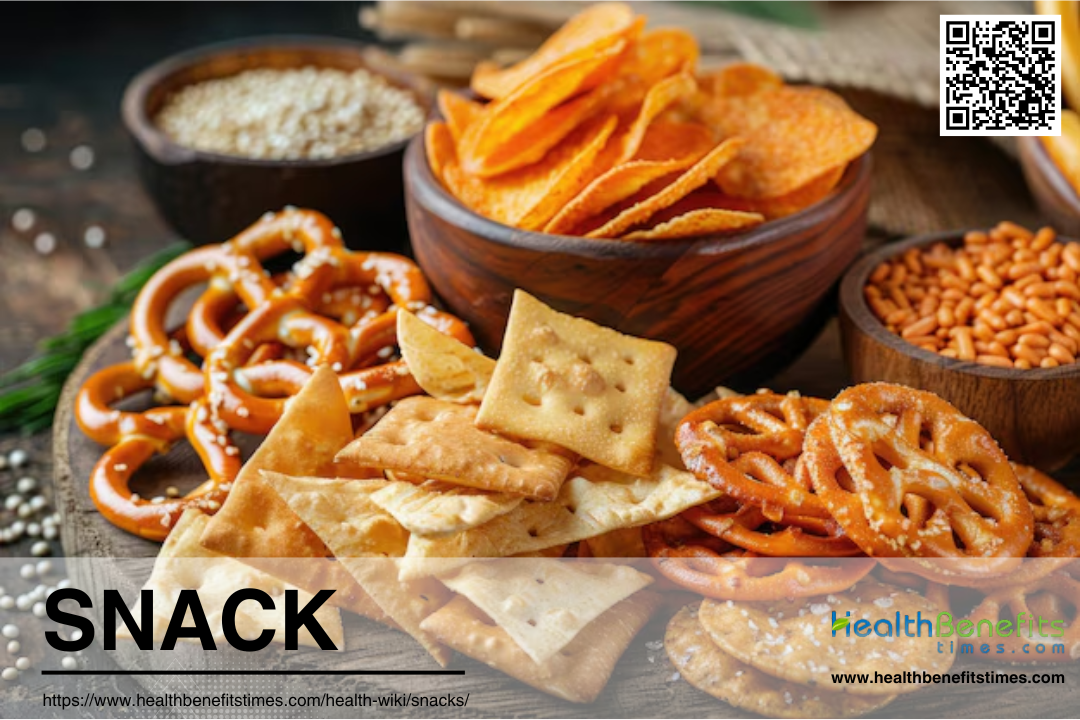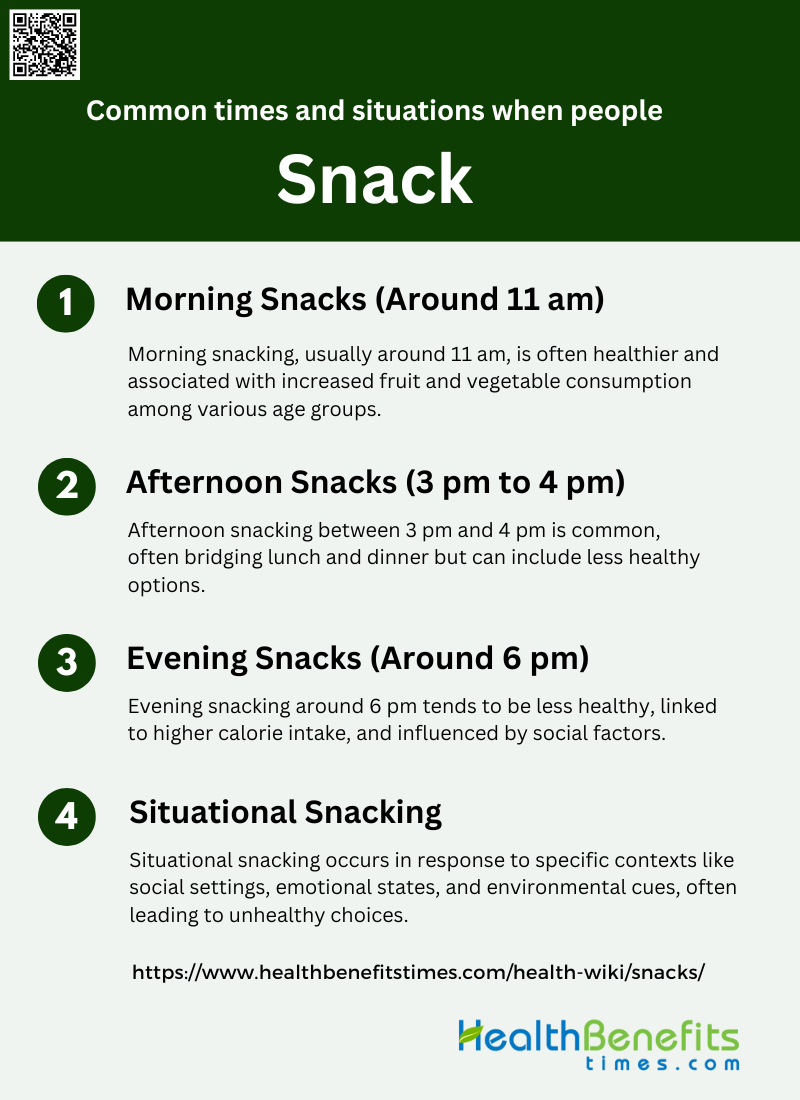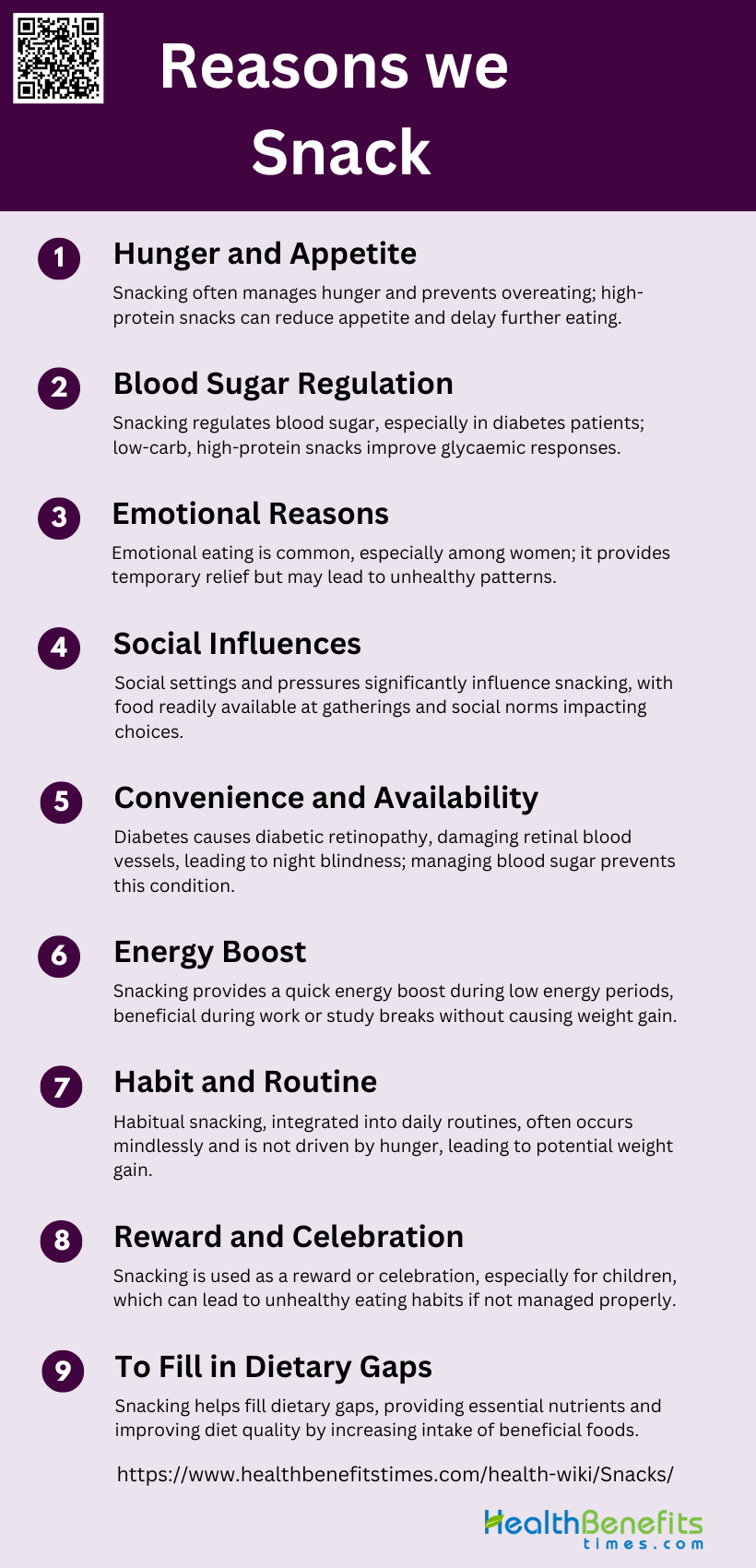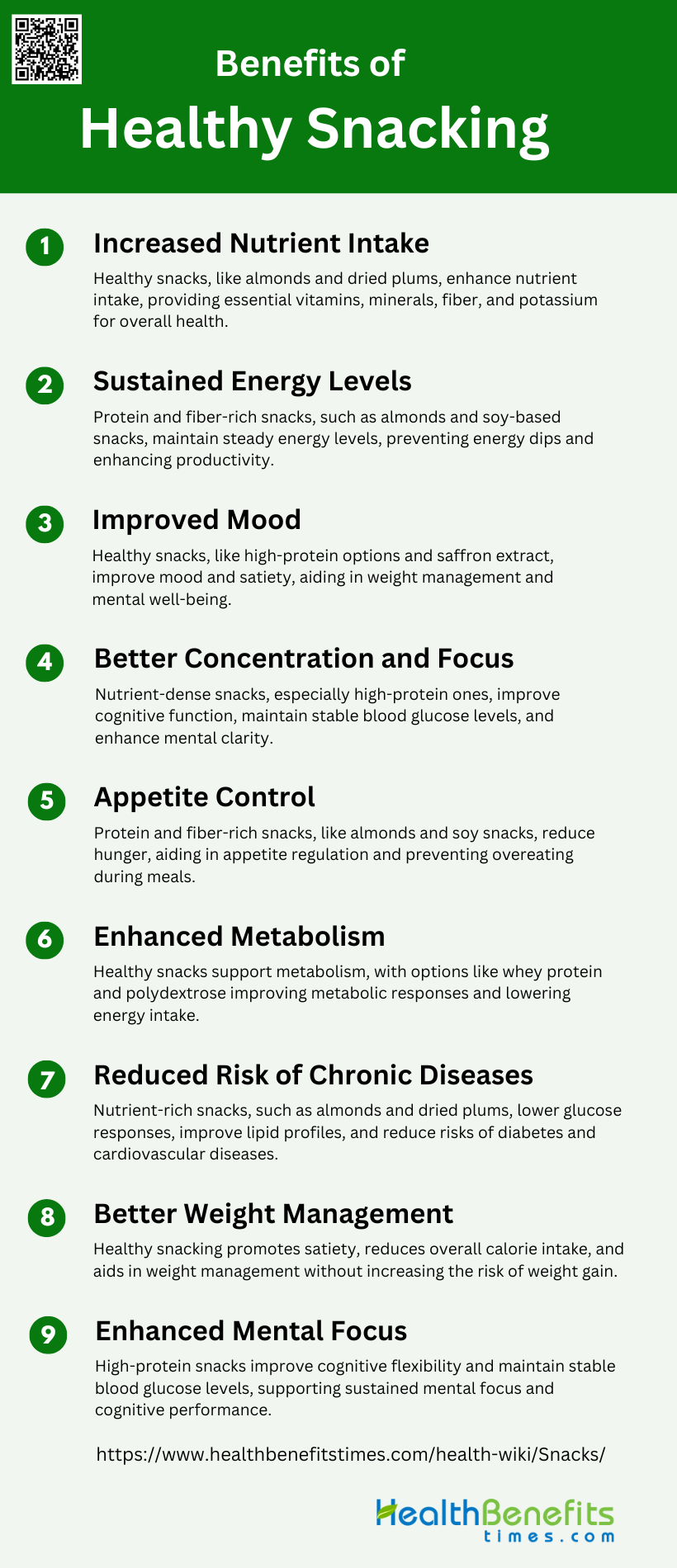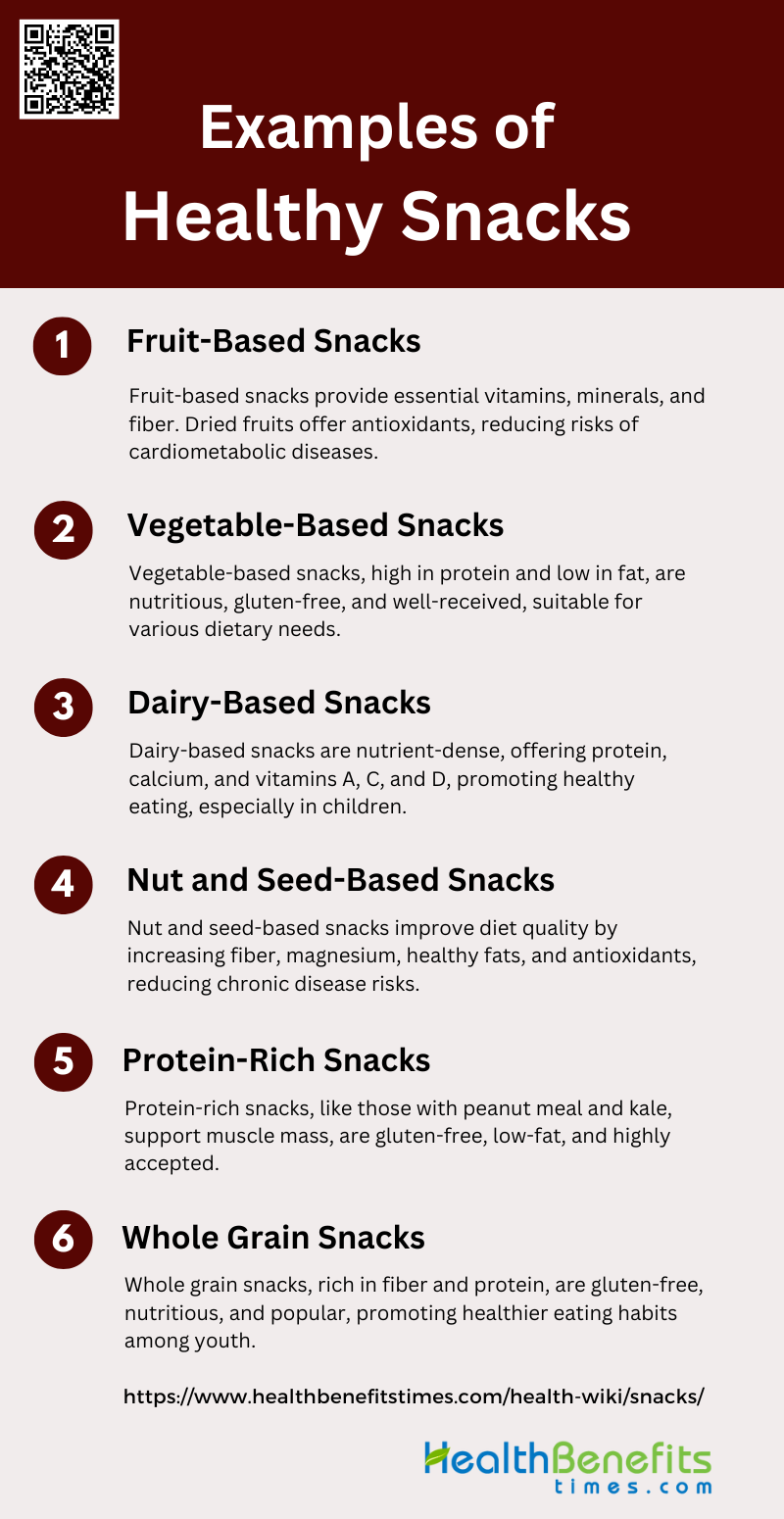Snacks are small portions of food consumed between main meals, such as breakfast, lunch, and dinner. They serve various purposes, including curbing hunger, providing energy, and offering nutritional benefits. The definition of a snack can vary widely, but it generally includes items that are quick and convenient to eat. Common motivations for snacking include hunger, social influences, and environmental factors like food availability. While snacks can contribute positively to dietary intake by providing essential nutrients, they can also lead to unhealthy eating habits if they are high in sugars, salts, and unhealthy fats. Therefore, choosing healthier snack options is crucial for maintaining overall health and well-being.
Types of Snacks
Snacks come in a wide variety of forms and flavors, catering to different tastes and preferences. From savory to sweet, healthy to indulgent, there’s a snack for every occasion. Below is a list of popular types of snacks that you can enjoy at any time of the day:
1. Sweet Snacks
Sweet snacks are often characterized by their high sugar content and are typically consumed for their pleasurable taste. These snacks include items such as candies, cookies, cakes, and pastries. Research indicates that sweet snacks are highly reinforcing, especially after the consumption of non-nutritive sweetened beverages, which can increase the motivation to consume sweet snacks later in the day. Additionally, sweet snacks contribute significantly to the total energy intake and added sugars in children’s diets, with nearly half of the energy from snacks coming from sweet items like cookies and pastries. Efforts to reduce the consumption of sweet snacks among children are crucial, as high sugar intake is linked to various health issues, including obesity and dental problems.
2. Savory Snacks
Savory snacks are typically salty or umami-flavored and include items such as chips, pretzels, and crackers. These snacks are often consumed for their satisfying taste and texture. Studies have shown that savory snacks can be less reinforcing than sweet snacks, particularly after the consumption of sugar-sweetened beverages. However, savory snacks can still contribute significantly to sodium intake, which is a concern for long-term health, especially in children. For instance, an intervention study found that providing low-sugar snacks to children resulted in an increase in the sodium content of the snacks, highlighting the need to balance both sugar and salt content in children’s diets.
3. Plant-based Snacks
Plant-based snacks are derived from plant sources and include items such as fruits, vegetables, nuts, and seeds. These snacks are often promoted for their health benefits, including high fiber content and essential nutrients. Research has shown that plant-based snacks like carob-containing snacks can have a low glycemic index, leading to increased satiety and lower energy intake at subsequent meals. Additionally, plant-based snacks can help improve the overall nutritional quality of children’s diets by providing essential vitamins and minerals that are often lacking in energy-dense, nutrient-poor snacks. Encouraging the consumption of plant-based snacks can be a valuable strategy in promoting healthier eating habits.
4. Salty Snacks
Salty snacks are a subset of savory snacks that are particularly high in sodium. Common examples include potato chips, salted nuts, and pretzels. These snacks are often consumed for their addictive taste and crunchy texture. While they can be enjoyable, salty snacks contribute significantly to sodium intake, which can have adverse effects on blood pressure and cardiovascular health. Studies have shown that interventions aimed at reducing sugar intake in children’s snacks can inadvertently increase the sodium content, underscoring the need for a balanced approach to snack formulation. Reducing the consumption of salty snacks and promoting healthier alternatives is essential for long-term health.
5. Healthy Snacks
Healthy snacks are those that provide essential nutrients without excessive calories, sugars, or unhealthy fats. Examples include fresh fruits, vegetables, whole grains, and low-fat dairy products. Research has demonstrated that healthy snacks can play a crucial role in improving dietary quality and reducing the risk of chronic diseases. For instance, interventions that increase access to low-sugar foods and beverages have been shown to reduce sweet-snack consumption and improve healthier food purchasing among low-income youth. Additionally, healthy snacks like carob-containing snacks can promote satiety and reduce overall energy intake, contributing to better weight management and glycemic control.
6. Junk Snacks
Junk snacks are typically high in calories, sugars, unhealthy fats, and sodium, while being low in essential nutrients. These snacks include items such as candy bars, sugary drinks, and fried snacks. The consumption of junk snacks is a major concern, especially among children, as it can lead to poor dietary habits and increased risk of obesity and related health issues. Studies have shown that junk snacks contribute significantly to the total energy intake and added sugars in children’s diets, with a heavy reliance on energy-dense, nutrient-poor foods. Efforts to reduce the availability and consumption of junk snacks, particularly in school settings, are essential for promoting healthier eating behaviors and improving overall health outcomes.
Common times and situations when people snack
Snacking is a ubiquitous part of daily life, providing quick energy boosts and satisfying hunger between meals. Different times of the day and various situations often prompt people to reach for a snack. Here are some common times and situations when people tend to snack:
1. Morning Snacks (Around 11 am)
Morning snacking, typically around 11 am, is a common practice among various age groups. Research indicates that morning snacks are often healthier compared to snacks consumed later in the day. For instance, a study on French adults found that morning snacks had the lowest energy density and the highest nutrient density, making them a healthier option compared to afternoon and evening snacks. Additionally, morning snacking has been associated with increased fruit and vegetable consumption, which contributes positively to overall dietary quality. This time period is also less frequently reported for snacking compared to other times of the day, suggesting that those who do snack in the morning may be more mindful of their choices. Therefore, morning snacks can be an opportunity to boost nutrient intake and maintain energy levels throughout the day.
2. Afternoon Snacks (3 pm to 4 pm)
Afternoon snacking, particularly between 3 pm and 4 pm, is a prevalent behavior among many individuals. This time frame is often the most common for snacking, as evidenced by a study on Canadians which found that 36.3% of snacking occurred between 3 pm and 8 pm. Afternoon snacks can serve as a bridge between lunch and dinner, helping to maintain energy levels and prevent overeating during the evening meal. However, the nutritional quality of these snacks can vary. For example, children often consume more discretionary, less healthy snacks during this period, which can contribute to poor dietary habits. Additionally, the context of snacking, such as snacking while watching TV or hanging out with friends, can influence the type and amount of food consumed, often leading to less healthy choices. Therefore, it is important to encourage healthier snack options during the afternoon to improve overall dietary quality.
3. Evening Snacks (Around 6 pm)
Evening snacking, typically around 6 pm, is another common practice, but it is often associated with less healthy eating behaviors. Studies have shown that evening snacks are more likely to be high in energy density and lower in nutrient density compared to snacks consumed earlier in the day. This can contribute to higher caloric intake and poorer dietary quality. Additionally, evening snacking has been linked to higher body mass index (BMI) and obesogenic eating behaviors, such as consuming fast food and eating while distracted. Social factors also play a significant role in evening snacking, with the presence of others eating increasing the likelihood of snacking and influencing the types of foods consumed. Therefore, reducing evening snacking or choosing healthier options can be an important strategy for weight management and improving overall health.
4. Situational Snacking
Situational snacking refers to the consumption of snacks in response to specific situations or contexts, rather than at regular times of the day. This type of snacking is influenced by various factors, including social norms, emotional states, and environmental cues. For instance, people are more likely to snack when they are in the presence of others who are eating, and this social influence can affect both the amount and type of food consumed. Emotional factors, such as coping with negative emotions or rewarding oneself, also play a significant role in situational snacking. Additionally, the availability of snacks in the home and other environments can influence snacking behavior, with greater availability of unhealthy foods being associated with higher snack intake. Understanding the contexts and motivations behind situational snacking can help in developing targeted interventions to promote healthier snacking habits.
Reasons we Snack
Snacking is a common behavior influenced by various factors beyond just hunger. From emotional triggers to social settings, the reasons people reach for a snack are diverse and complex. Here are some key reasons why people snack:
1. Hunger and Appetite
Research indicates that consuming snacks can help manage hunger and prevent overeating during main meals. For instance, a study found that high-protein snacks can delay eating initiation and reduce overall appetite compared to no snacking, suggesting that snacks can play a role in appetite control and satiety. Additionally, almonds consumed as snacks were shown to reduce hunger and desire to eat, highlighting their potential in managing appetite.
2. Blood Sugar Regulation
Snacking can also be a strategy for regulating blood sugar levels, particularly in individuals with diabetes. A study on type 2 diabetes patients found that a low-carbohydrate, protein-rich bedtime snack significantly lowered fasting plasma glucose levels compared to a high-carbohydrate snack or no snack at all. Similarly, consuming almonds instead of high-carbohydrate snacks resulted in lower glycaemic responses, indicating that the type of snack can influence blood sugar regulation.
3. Emotional Reasons
Emotional eating is a common reason for snacking, often used as a coping mechanism for negative emotions. Research has shown that women, in particular, are more likely to snack to cope with negative emotions, and this behavior is associated with higher BMI and dieting tendencies. Emotional snacking can provide temporary relief from stress or sadness but may lead to unhealthy eating patterns and weight gain over time.
4. Social Influences
Social contexts and pressures significantly influence snacking behaviors. People often snack in social settings, such as parties or gatherings, where food is readily available and eating is part of the social experience. Studies have found that social pressure is a notable reason for snacking, especially among those who are dieting. Additionally, social norms that emphasize healthy eating can encourage the consumption of nutrient-rich snacks.
5. Convenience and Availability
The convenience and availability of snacks play a crucial role in snacking habits. Easy access to snacks, especially unhealthy ones, can lead to increased consumption. Research indicates that the home availability of unhealthy foods is positively associated with higher snack intake among children. This suggests that the environment significantly impacts snacking behaviors, making it essential to manage the availability of snacks to promote healthier choices.
6. Energy Boost
Snacking is often used as a quick way to boost energy levels, particularly during periods of low energy or fatigue. Studies have shown that snacks can provide a temporary increase in energy, which is why they are commonly consumed during work or study breaks. For example, almonds consumed as snacks were found to provide post-ingestive metabolic benefits without increasing the risk of weight gain, making them a suitable option for an energy boost.
7. Habit and Routine
This habitual snacking is often not driven by hunger but by the routine itself. Research has shown that people snack out of habit, which can lead to mindless eating and potential weight gain if the snacks are not healthy. Understanding the habitual nature of snacking can help in developing strategies to replace unhealthy snacks with healthier options.
8. Reward and Celebration
Snacking is frequently used as a form of reward or celebration. Parents often give snacks to children as a reward for good behavior or to celebrate achievements and special occasions. However, this practice can lead to unhealthy eating habits and reduced adherence to dietary recommendations. It is important to find healthier ways to reward and celebrate to avoid the negative impacts of frequent snacking.
9. To Fill in Dietary Gaps
Snacking can help fill in dietary gaps by providing essential nutrients that may be missing from main meals. For instance, high-protein snacks can improve diet quality by increasing protein intake and reducing the consumption of high-fat and high-sugar foods. Similarly, almonds as snacks were found to increase dietary monounsaturated fat and α-tocopherol intakes, contributing to a more balanced diet.
Tips for Healthier Snack Choices
Making healthier snack choices can be a game-changer for your overall well-being. Here are some practical tips to help you select nutritious snacks that satisfy your hunger and support your health goals.
1. Opt for Whole Foods
Whole foods are minimally processed and packed with nutrients. Consider these options:
- Fruits and Vegetables: Fresh, frozen, or dried fruits and vegetables are excellent snacks. They are rich in vitamins, minerals, and fiber.
- Nuts and Seeds: Almonds, walnuts, chia seeds, and flaxseeds provide healthy fats, protein, and fiber.
- Whole Grains: Snacks like whole grain crackers, popcorn, and oatmeal can keep you full longer due to their high fiber content.
2. Include Protein-Rich Snacks
Protein helps maintain muscle mass and keeps you feeling full. Here are some protein-packed snacks:
- Greek Yogurt: High in protein and can be paired with fruits or nuts.
- Hard-Boiled Eggs: Easy to prepare and portable.
- Soy Flour Biscuits: These are rich in protein and other essential nutrients like iron and calcium, making them a great snack option.
3. Watch Portion Sizes
Even healthy snacks can contribute to weight gain if consumed in large quantities. Use these tips to manage portions:
- Pre-Portion Snacks: Divide snacks into individual portions to avoid overeating.
- Mindful Eating: Pay attention to hunger cues and avoid eating out of boredom or stress.
4. Read Labels Carefully
Understanding food labels can help you make better choices:
- Check for Added Sugars: Many snacks contain hidden sugars. Look for snacks with low or no added sugars.
- Look for Fiber: High-fiber snacks can help with digestion and keep you full longer.
5. Prepare Snacks at Home
Homemade snacks allow you to control ingredients and avoid unhealthy additives:
- Crispy Kale Chips: A nutritious alternative to potato chips.
- Peanut Butter and Jelly Yogurt: A delicious and healthy snack option.
6. Smart Grocery Shopping
Navigating the grocery store effectively can help you make healthier choices:
- Shop the Perimeter: Fresh produce, dairy, and whole grains are usually located around the perimeter of the store.
- Avoid Impulse Buys: Stick to your shopping list to avoid unhealthy snacks.
7. Use Technology for Support
Mobile apps can provide healthy snack ideas and help you make better choices:
- Nutrition Apps: Some apps offer healthy tip push notifications and easy-to-fix snack recipes tailored to your dietary preferences.
8. Encourage Healthy Snacking in Children
Children need nutrient-dense snacks to support their growth and energy needs:
- Energy-Dense Snacks: Young children burn more energy and benefit from snacks like fruits, vegetables, and whole grains.
- Interactive Choices: Let children help choose and prepare their snacks to make healthy eating fun.
Benefits of Healthy Snacking
Healthy snacking can play a crucial role in maintaining overall well-being by providing essential nutrients and sustaining energy levels throughout the day. It can also help manage weight and improve mood. Here are some key benefits of healthy snacking:
1. Increased Nutrient Intake
Healthy snacking can significantly enhance nutrient intake by providing essential vitamins and minerals that might be missed during regular meals. For instance, almonds, when consumed as snacks, have been shown to increase dietary monounsaturated fat and α-tocopherol intakes, which are beneficial for overall health. Similarly, dried plums (DP) as snacks can improve nutrient consumption, particularly dietary fiber and potassium, which are crucial for maintaining various bodily functions. Therefore, incorporating nutrient-rich snacks like nuts and fruits can help meet daily nutritional requirements and improve diet quality.
2. Sustained Energy Levels
Healthy snacking can help maintain sustained energy levels throughout the day. Snacks that are high in protein and fiber, such as almonds and soy-based snacks, can provide a steady release of energy, preventing the energy dips that often occur between meals. For example, almonds have been shown to lower serum glucose responses postprandially, which helps in maintaining stable energy levels. This sustained energy release can enhance overall productivity and reduce feelings of fatigue.
3. Improved Mood
Healthy snacking can also positively influence mood. High-protein snacks, such as those containing soy, have been found to beneficially influence aspects of mood and cognition in adolescents. Additionally, the consumption of Satiereal, a saffron extract, has been shown to reduce snacking frequency and enhance satiety, which can contribute to mood improvement and weight loss in mildly overweight women. These findings suggest that the right choice of snacks can help in mood regulation and overall mental well-being.
4. Better Concentration and Focus
Consuming healthy snacks can improve concentration and focus. High-protein snacks, for instance, have been shown to increase cognitive flexibility and reduce confusion-bewilderment, thereby enhancing cognitive function. Moreover, almonds, which are rich in nutrients, can help maintain stable blood glucose levels, which is crucial for sustained mental focus. Therefore, incorporating nutrient-dense snacks into the diet can support better cognitive performance and mental clarity.
5. Appetite Control
Healthy snacking plays a crucial role in appetite control. Snacks high in protein and fiber, such as almonds and soy-based snacks, have been shown to reduce hunger and the desire to eat, thereby aiding in appetite regulation. For example, high-protein soy snacks can delay eating initiation and reduce appetite more effectively than high-fat snacks. This appetite control can prevent overeating during main meals and contribute to better weight management.
6. Enhanced Metabolism
Healthy snacking can enhance metabolism by providing the body with a steady supply of nutrients that support metabolic processes. For instance, snacks containing whey protein and polydextrose have been shown to induce a sustained reduction in daily energy intake and improve metabolic responses. Additionally, almonds, when consumed as snacks, can lower glycaemia and energy intake, which are beneficial for metabolic health. These findings indicate that the right choice of snacks can support a healthy metabolism.
7. Reduced Risk of Chronic Diseases
Incorporating healthy snacks into the diet can reduce the risk of chronic diseases. For example, almonds have been shown to lower serum glucose responses and improve lipid profiles, which are important factors in reducing the risk of type 2 diabetes and cardiovascular diseases. Similarly, dried plums can improve total antioxidant capacity and maintain plasma LDL-C levels, which are beneficial for reducing chronic disease risk. Therefore, choosing nutrient-rich snacks can contribute to long-term health benefits.
8. Better Weight Management
Healthy snacking can aid in better weight management by promoting satiety and reducing overall calorie intake. For instance, consuming almonds as snacks has been shown to reduce hunger and energy intake without increasing the risk of weight gain. Additionally, Satiereal supplementation has been found to reduce snacking frequency and contribute to body weight loss in mildly overweight women. These findings suggest that healthy snacking can be an effective strategy for weight control.
9. Enhanced Mental Focus
Healthy snacking can enhance mental focus by providing essential nutrients that support brain function. High-protein snacks, such as those containing soy, have been shown to improve cognitive flexibility and reduce confusion, thereby enhancing mental focus. Additionally, almonds, which help maintain stable blood glucose levels, can support sustained mental clarity and focus. Therefore, incorporating nutrient-dense snacks into the diet can support better cognitive performance and mental sharpness.
Examples of Healthy Snacks
Choosing healthy snacks can significantly contribute to a balanced diet and help maintain energy and focus throughout the day. These snacks are not only nutritious but also satisfying and easy to prepare. Here are some examples of healthy snacks:
1. Fruit-Based Snacks
Fruit-based snacks are an excellent choice for a healthy diet due to their high nutrient density and natural sweetness. According to research, snacks that list fruit as the main ingredient tend to have higher nutrient density scores, providing essential vitamins and minerals such as vitamin A, vitamin C, and dietary fiber. These snacks are also associated with lower saturated fat content, making them a healthier alternative to many traditional snack options. Additionally, dried fruits, which are a popular form of fruit-based snacks, are rich in bioactive compounds and antioxidants. These compounds can help modulate the risk of cardiometabolic and other non-communicable diseases, making dried fruits a beneficial addition to a balanced diet.
2. Vegetable-Based Snacks
Vegetable-based snacks are gaining popularity due to their high nutritional content and health benefits. Studies have shown that snacks made from combinations of whole grains and vegetables, such as Buckwheat-Peanut Meal-Kale (BPK) and Sorghum-Peanut Meal-Okra (SPO), are not only high in protein but also gluten-free and low in fat. These snacks have been well-received in sensory evaluations, indicating their potential for consumer acceptability. Moreover, these snacks can be easily prepared at home, offering a convenient and healthy alternative for individuals, including those with dietary restrictions such as gluten intolerance.
3. Dairy-Based Snacks
Dairy-based snacks are another nutritious option, particularly for children. Research indicates that snacks listing dairy as the main ingredient have higher nutrient density scores, providing significant amounts of protein, calcium, and vitamins A, C, and D. These snacks are also associated with lower saturated fat content, making them a healthier choice compared to many other snack options. The inclusion of dairy in snacks not only enhances their nutritional profile but also improves their overall acceptability among children, making them a practical option for promoting healthy eating habits in younger populations.
4. Nut and Seed-Based Snacks
Nut and seed-based snacks are highly recommended for their rich nutrient profile and health benefits. Replacing typical American snacks with tree nuts has been shown to improve diet quality by increasing the intake of essential nutrients such as dietary fiber, magnesium, and healthy fats while reducing empty calories, added sugars, and sodium. Nuts and seeds are also excellent sources of bioactive compounds and antioxidants, which can help reduce the risk of various chronic diseases. Frequent consumption of these snacks is encouraged to fully benefit from their health-promoting properties.
5. Protein-Rich Snacks
Protein-rich snacks are essential for maintaining muscle mass and overall health. Snacks made from whole grains and high-protein ingredients like peanut meal and kale have been shown to be particularly beneficial. These snacks are not only high in protein but also gluten-free and low in fat, making them suitable for a wide range of dietary needs. Sensory evaluations have indicated high acceptability for these snacks, suggesting that they are both nutritious and enjoyable to eat. Additionally, these snacks can be easily prepared at home, providing a convenient and healthy option for individuals looking to increase their protein intake.
6. Whole Grain Snacks
Whole grain snacks are a staple in many diets due to their high nutritional value. Grains such as quinoa, buckwheat, and sorghum are used to create snacks that are rich in dietary fiber, proteins, and essential micronutrients. These snacks are often gluten-free and can be combined with vegetables to enhance their nutritional profile. Research has shown that whole grain snacks are not only nutritious but also have good sensory properties, making them a popular choice among consumers. Additionally, whole grain snacks can be easily marketed and sold in various settings, including corner stores, to promote healthier eating habits among youth.
Common Misconceptions about Snacking
Snacking often gets a bad reputation, but many beliefs about it are based on myths rather than facts. Understanding these misconceptions can help make better dietary choices and improve overall health. Here are some common misconceptions about snacking:
1. Myth: Cutting out Snacks Makes You Lose Weight
Contrary to popular belief, cutting out snacks does not necessarily lead to weight loss. Research indicates that the timing and type of snacks consumed play a significant role in weight management. For instance, a study found that consuming a high-protein snack in the afternoon can improve appetite control and diet quality, which may aid in weight management. Additionally, another study showed that structured snacking, such as consuming a ready-to-eat cereal in the evening, can help regulate excess energy intake and contribute to weight loss in individuals who snack at night. Therefore, rather than eliminating snacks altogether, focusing on the quality and timing of snacks may be more effective for weight management.
2. Myth: You Should Never Have Treats
The idea that one should never have treats is a misconception. Allowing occasional treats can be part of a balanced diet and may help in maintaining long-term dietary adherence. For example, a study on adolescents found that consuming high-protein soy snacks not only improved appetite and satiety but also positively influenced mood and cognition. This suggests that incorporating treats in moderation, especially those with nutritional benefits, can support overall well-being without derailing diet efforts. The key is to choose treats wisely and consume them in moderation to avoid excessive calorie intake.
3. Myth: Snacking Hinders Dieting Efforts
Snacking does not necessarily hinder dieting efforts; in fact, it can support them when done correctly. Research has shown that snacking on high-protein foods can delay eating initiation and reduce overall appetite, which may help in controlling calorie intake. Additionally, structured snacking, such as consuming a bedtime milk snack, has been found to have no adverse effects on next morning metabolism and appetite, suggesting that it does not hinder weight management efforts. Therefore, strategic snacking can be a useful tool in a dieting regimen, helping to manage hunger and prevent overeating during main meals.
4. Myth: Snacking Spoils Your Appetite
The belief that snacking spoils your appetite is not entirely accurate. While it is true that snacking can affect hunger levels, the type of snack consumed plays a crucial role. For instance, a study found that consuming a high-protein snack in the afternoon reduced appetite more effectively than a high-fat snack, without leading to increased overall calorie intake. Moreover, another study indicated that bedtime milk ingestion reduced hunger and increased fullness during the evening, without affecting next morning appetite. These findings suggest that snacking, particularly on high-protein foods, can help manage hunger without spoiling the appetite for subsequent meals.
5. Myth: Snacking at Night is Bad for Weight Loss
The notion that snacking at night is inherently bad for weight loss is a misconception. While some studies have shown that nighttime snacking can reduce fat oxidation and increase LDL cholesterol, potentially increasing the risk of obesity, other research suggests that the type of nighttime snack matters. For example, consuming a bedtime milk snack did not alter next morning metabolism or appetite, indicating that it may not negatively impact weight management. Additionally, structured nighttime snacking, such as consuming a ready-to-eat cereal, has been shown to help regulate energy intake and promote weight loss in night snackers. Therefore, the impact of nighttime snacking on weight loss depends on the type and quantity of the snack consumed.


